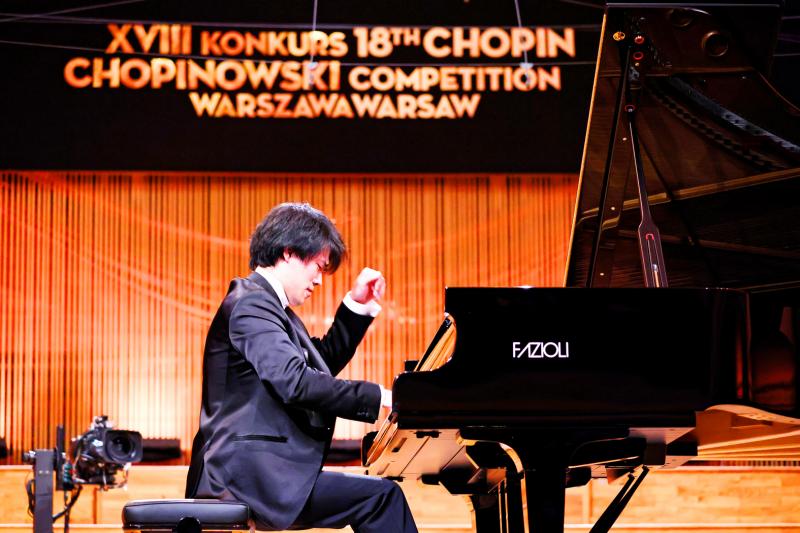Held every five years, the International Chopin Piano Competition (often referred to as the Chopin Competition) concluded on Oct. 21, with Canadian pianist Bruce (Xiaoyu) Liu winning the first prize and being awarded 40,000 euros (approximately US$45,000) and contracts for records and concerts.
Through three weeks of playing Chopin’s works, 87 young pianists from all over the world competed in Warsaw, Poland. The program included technical challenges like the Etudes, musical challenges like Polish dances — mazurkas and polonaises — as well as concertos with an orchestra.
Liu was born in Paris to Chinese parents before emigrating to Canada when he was a child. He started to learn piano at the age of eight and graduated from the Conservatoire de musique de Quebec a Montreal, under the supervision of Canadian Vietnamese pianist Dang Thai Son, winner of the 10th Chopin Competition in 1980.

Photo: EPA-EFE 照片:歐新社
Arguably the most important competition in the piano world, the Chopin Competition is named after Polish composer Fryderyk Chopin and was first held in 1927. The 18th session was originally scheduled to be held in 2020 but was postponed to this year due to the COVID-19 pandemic.
Some of the big names of classical music like Maurizio Polini of Italy, Marta Argerich of Argentina and Krystian Zimerman of Poland went on to become international superstars after winning the Chopin Competition. The renowned “piano poet” Fou Ts’ong, who died of COVID-19 in the UK last year, won third prize and Best Mazurkas at the Chopin Competition in 1955.
For Taiwan, just like its impressive achievements in this year’s Olympics, three Taiwanese pianists, namely Chang Kai-min, Su Szu-yu and Hsieh Wei-ting, advanced to the second round of the competition along with 42 other international contestants. Like the US, three of whose pianists also advanced to the second round, this is Taiwan’s best performance so far at the Chopin Competition in terms of the number of contestants.
(Lin Lee-kai, Taipei Times)
五年一度的蕭邦國際鋼琴大賽,十月二十一日落幕,由加拿大籍鋼琴家劉曉禹摘下首獎,獲得四萬歐元(約為新台幣一百三十一萬元)獎金,以及唱片與演奏會合約。
在波蘭華沙舉行、為期三週的比賽中,八十七位來自世界各地的青年鋼琴家輪番演奏蕭邦作品,曲目包括考驗技巧的練習曲,考驗音樂性的馬祖卡舞曲及波蘭舞曲等波蘭舞蹈音樂,以及與管弦樂團合奏協奏曲。
劉曉禹出生於巴黎,父母來自中國,童年時舉家移民加拿大。他八歲開始學鋼琴,後畢業於蒙特利爾音樂學院,師事加拿大籍越南裔鋼琴家鄧泰山。鄧泰山亦為一九八○年第十屆蕭邦鋼琴大賽冠軍得主。
蕭邦鋼琴大賽可說是鋼琴界最重要的比賽,以波蘭作曲家弗雷德里克‧蕭邦為名,一九二七年首次舉辦。第十八屆比賽原定於二○二○年舉行,因COVID-19疫情而延至今年。
先前的蕭邦鋼琴大賽首獎得主,例如義大利的毛里齊奧‧波里尼、阿根廷的瑪塔‧阿格麗希、波蘭的克里斯提安‧齊瑪曼等,日後都成為名家巨星,享譽國際。去年因感染COVID-19而在英國辭世的著名「鋼琴詩人」傅聰,亦曾在一九五五年獲得蕭邦鋼琴大賽第三名,以及「最佳馬祖卡演奏獎」。
對台灣而言,如同今年奧運的亮眼表現,本屆蕭邦鋼琴大賽有張凱閔、蘇思羽及謝維庭等三位台灣參賽者晉級第二輪,在第二輪的四十五位各國好手中,台灣拿下三席,與美國並列,是台灣以晉級人數而言有史以來最佳成績。
(台北時報林俐凱)

In an effort to fight phone scams, British mobile phone company O2 has introduced Daisy, an AI designed to engage phone con artists in time-wasting conversations. Daisy is portrayed as a kindly British granny, exploiting scammers’ tendency to target the elderly. Her voice, based on a real grandmother’s for authenticity, adds to her credibility in the role. “O2” has distributed several dedicated phone numbers online to direct scammers to Daisy instead of actual customers. When Daisy receives a call, she translates the scammers’ spoken words into text and then responds to them accordingly through a text-to-speech system. Remarkably, Daisy

A: Isn’t the Met Gala, the Metropolitan Museum of Art’s fundraiser, chaired by Vogue editor-in-chief Anna Wintour? B: Yeah, the blockbuster “The Devil Wears Prada” is allegedly based on her story. A: This year’s four co-chairs are actor Colman Domingo, F1 driver Lewis Hamilton, rapper A$AP Rocky and Louis Vuitton men’s creative director Pharrell Williams. B: And basketball superstar LeBron James is the honorary chair. A: I can’t wait to see the lineup of stars on the red carpet. A: 大都會博物館慈善晚宴「Met Gala」,是《時尚》雜誌全球總監安娜溫圖為該館服裝學院主辦的募款活動吧? B: 對啊,電影《穿著普拉達的惡魔》據說是以她為範本。 A: 今年晚宴共同主席還有:演員柯爾曼多明哥、F1賽車手路易斯漢米頓、饒舌歌手A$AP洛基、LV男裝創意總監菲董。 B: 籃球巨星勒布朗詹姆斯則是榮譽主席。 A: 紅毯上的全球星光真令人期待! (By Eddy Chang, Taipei Times/台北時報張迪)

Bilingual Story is a fictionalized account. 雙語故事部分內容純屬虛構。 Emma had reviewed 41 resumes that morning. While the ATS screened out 288 unqualified, she screened for AI slop. She could spot it a mile away. She muttered AI buzzwords like curses under her breath. “Team player.” “Results-driven.” “Stakeholder alignment.” “Leveraging core competencies.” Each resume reeked of AI modeling: a cemetery of cliches, tombstones of personality. AI wasn’t just changing hiring. It was draining the humanity from it. Then she found it: a plain PDF cover letter. No template. No design flourishes. The first line read: “I once tried to automate my

1. 他走出門,左右看一下,就過了馬路。 ˇ He walked outside, looked left and right, and crossed the road. χ He walked outside and looked left and right, crossed the road. 註︰並列連接詞 and 在這句中連接三個述語。一般的結構是 x, y, and z。x and y and z 是加強語氣的結構,x and y, z 則不可以。 2. 他們知道自己的弱點以及如何趕上其他競爭者。 ˇ They saw where their weak points lay and how they could catch up with the other competitors. χ They saw where their weak points lay and how to catch up with the other competitors. 註:and 一般連接同等成分,結構相等的單詞、片語或子句。誤句中 and 的前面是子句,後面是不定詞片語,不能用 and 連接,必須把不定詞片語改為子句,and 前後的結構才相等。 3. 她坐上計程車,直接到機場。 ˇ She took a cab, which took her straight to the airport. ˇ She took a cab and it took her straight